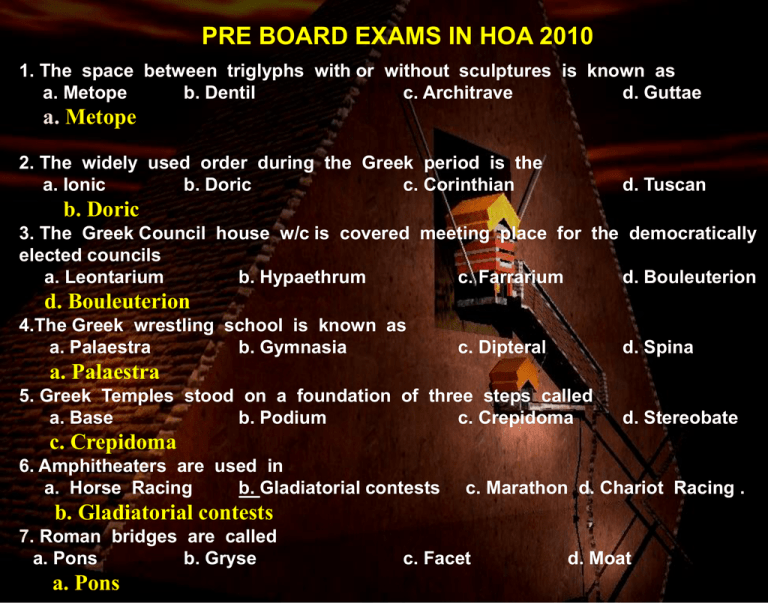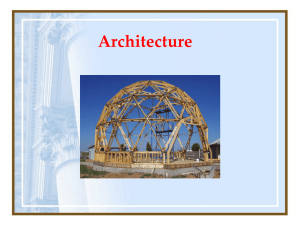File - Arki Reviewer
advertisement

PRE BOARD EXAMS IN HOA 2010 1. The space between triglyphs with or without sculptures is known as a. Metope b. Dentil c. Architrave d. Guttae a. Metope 2. The widely used order during the Greek period is the a. Ionic b. Doric c. Corinthian d. Tuscan b. Doric 3. The Greek Council house w/c is covered meeting place for the democratically elected councils a. Leontarium b. Hypaethrum c. Farrarium d. Bouleuterion d. Bouleuterion 4.The Greek wrestling school is known as a. Palaestra b. Gymnasia c. Dipteral d. Spina a. Palaestra 5. Greek Temples stood on a foundation of three steps called a. Base b. Podium c. Crepidoma d. Stereobate c. Crepidoma 6. Amphitheaters are used in a. Horse Racing b. Gladiatorial contests c. Marathon d. Chariot Racing . b. Gladiatorial contests 7. Roman bridges are called a. Pons b. Gryse a. Pons c. Facet d. Moat 8. That which corresponds to the Greek Agora is the Roman a. Place b. Forum c. Plaza d. Market b. Forum 9. The space between columns is called a. Interposition b. Intercupola c. Intercapedo d.Intercolumnation d.Intercolumnation 10. The upright stone slab containing the name of the dead found in the mastaba is a. pilaster b. band c. scuncheon d. stele d. stele 11. The architects of the Parthenon are a. Ictinus & Callicrates b. Pheidias & Mnesicles c. Anthemius & Ictinus d. Theron & Pheidias a. Ictinus & Callicrates 12.The builder of the famous Pharaohs or Light House is a. Ptolemy ll b. Rameses ll c. Amenemhat 1 d. Senusrets a. Ptolemy ll 13.The favorite motifs of design of the Egyptians include the lotus , papyrus & a. scarab b. nipa c. palm d. cavetto c. palm 14. The palace proper found in Assyrian palaces is called a. Seraglio b. Khan c. Thalamus d. Jawab a. Seraglio 15. The male statue in kneeling position used in Greek Temples as columns & ornamental blocks a. Canephorae b. Quadrigas c. Telamones d. Atlantes d. Atlantes 16. The Epinaos is also called a. Trachelion b. Opisthodomos c. Posticum d. Portico c. Posticum 17. The Greek male statue used as columns is known as a. Canephorae b. Quadrigas c. Telamones d. Osiris c. Telamones 18. Another prehistoric burial mound term a. horus b. fillet c. tumulus d. barrows d. barrows 19. Art Nouveau in Germany is known as a. Jugendstil b. Bauhaus c. Empire Style d. Eclecticism a. Jugendstil 20. This is a gateway to a Dravidian temple for hindu architecture a. hypathrael b. torii c. torana d. gopura d. gopura 21. Pathenon is the largest Greek Temple which was the Crownig Glory of Temenos dedicated to ; a. god mnesicles b. goddess athena c. god parthenos d. goddess venus b. goddess athena 22. Completing the world-famous Pisa group of cath’l. & baptistery is the campanile known as a. Tower of London b. Leaning Tower c. Tower of Babel d. Tower of the Winds b. Leaning Tower 23 . What Architecture did they reintroduced the Classical Orders ? a. Romanesque b. Renaissance c.Gothic d. Age of the Revivals b. Renaissance 24. The palatial public bath generally raised on high platform within an enclosing wall i the a. Thermae b. Gymnasium c. Laconicum d. Triclinium a. Thermae 25. The biggest religious temple in the world known to be the temple mountain ; a. Borobudor Temple b. Ziggurat at Ur c. Angkor Wat Temple d. Stupa at Sanchi c. Angkor Wat Temple 26. Founder of Buddhism; a. Lao Tze b. Suryavarman II c. Gautama d.Brahman II c. Gautama 27. The European style of arch developed in the 17th to 18th Century characterized by oval spaces ,curved surfaces & conspicious use of decor , scupture & color; a. Rococo Arch b. Neo Classical Arch c. Baroque Arch d. Antiquarian Arch c. Baroque Arch 28. It began in Paris, it is a style of arch , primarily French in origin w/c represesnts the final phase of the baroque around the mid of 18th Century using rockworks,pebbles,coquilles& fantastic scrolls ; a. Rococo Arch b. Neo Classical Arch c. Baroque Arch d. Antiquarian Arch a. Rococo Arch 29. Most prominent Art Nouveau architect whose works includes the Guell Palace in Spain is a. Antonio Gaudi b. El Cid c. Henri Labrouste d. J.V. Louis a. Antonio Gaudi 30. The dry sweating room in the thermae is the a. Unctoria b. Sudatorium c. Palaestra d. apodyteria b. Sudatorium 31. The dressing room in the thermae is called a. Frigidarium b. Hypocaust c. Apodyteria d. laconicum c. Apodyteria 32. The private house of the Roman is the a. Megaron b. Villa c. Domus d. insula c. Domus 33. The Pantheon, Rome is known today as the a. Sta Maria, Rotunda b. Sta Maria Maggiore, Rome c. Sta Maria della Strada d. Sta. Maria Cancellaria, Rome a. Sta Maria, Rotunda 34. The small private bath, very usual in Roman palaces and houses were called a. Balneum b. Hypogeum c. Bathtub d. Sensorium a. Balneum 35. The bedroom in the domus is called a. Dormitorio b. Cubicula c. Thalamus d. alcoba b. Cubicula 36. A single line of column surrounding the naos wall is an arrangement called a. Peripteral b. Octasyle c. Monotriglyph d. Araeostyle a. Peripteral 37. The naos, epinaos and the _________ are the 3 chambers of the Greek temple a. Cella b. Posticum c. Peristyle d. Pronaos d. Pronaos 38. From Buddhist structure Stupa , the crowning umbrella is called a. chattri b. torana c. dagoba d. gopuram a. chattri 39. The Amygdaloidal trap formation of living rocks in Buddhist architecture is called ; a. wat b. rath c. lath d. stambha b. rath 40. The monastery designed w/ courts or shrines w/ a central square space surrounded by priest’s chambers. a. wat b. chaitya c. vihara d. stambha c. vihara 41. Art Nouveau in France is known as a. Beaux Arts b. Le Modern Style c. Stile Liberty d. Modernismo b. Le Modern Style 42. It is the considered as the world’s largest religious structure in the world a. St. Peter’s Basilica b. Istana Nurul Aman c. Borubudor d. Angkor Wat d. Angkor Wat 43. The Ibaloy house for the well-to-do families is called a. sirok b. Kalapaw c. Tarakip d. Dema d. Dema 44. It is the pd. in French w/c is characterized by pointed arches & geometric traceried wdos . a. Decorated b.Mannerist c.Baroque d. Lancet d. Lancet 45. The pattern produced by the lierne is called a. Sexpartite vault b. Quadripartite vault c. Pendant vault d. stellar vault d. stellar vault 46. It is the lavishly ornamented Spanish Baroque style of the early 18th century characterized by a reaction from the correct and frigid formalism a. Modernismo b. Moorish c. Arrab sque d. Churrigueresque d. Churrigueresque 47. The part of a the Elizabethan mansion which is located in a central position & connecting the various parts of the mansion is the a. Long Gallery b. Great Hall c. Great Corriddor d. Grand Staicase b. Great Hall 48. That part of the Elizabethan mansion w/c forms a dignified approach to the rooms above is a. vestibule b. Grand Landing c. Grand Staircase d. Grand Entry c. Grand Staircase 49. The Revival and Eclectic Architecture in 19th century Great Britain which is also used for its American counterpart a. Victorian Arch b. Carolingian Arch c. Tudor Arch d. Elizabethan Architecture a. Victorian Arch 50. A style of decoration in architecture and applied art developed principally in Belgium and France toward the end of 19thcent. characterized by organic & dynamic forms, w/o traces of historical styles a. Art Nouveau b. Beaux Arts c. Int’l .Architecture d. Colonial Arch a. Art Nouveau 51. Romanesque Revival in the USA was introduced by a. Louis Sullivan b. Henry H. Richardson c. Frank Lloyd Wright d. Richard Upjohn b. Henry H. Richardson 52. The master sculptor of the Parthenon is a. Scopas b. Mnesicles c. Pheidias d. Theron c. Pheidias 53. The architect of the Erectheion is a. Callicrates b. Mnesicles c. Theron d. Ictinus b. Mnesicles 54. The windows of the bahay na bato is the made up of a. calado b. Ventanilla c. capiz d. rakuh c. capiz 55. Found in the ground floor of the bahay na bato, it is where the carriages and saints floats or andas are usually kept a. patio b. Entresuelo c. Garahe d. zaguan d. zaguan 56. The central open spaced use as sleeping area for overnight guests in the T’boli house a. comun b. Lowa c. Bilik d. hanglad b. Lowa 57. The bedroom in the domus is called a. Dormitorio b. Cubicula c. Thalamus d. alcoba b. Cubicula 58. The bedroom in the megaron is called a. Thalamus b. Cuarto c. Cubicula d. harem a. Thalamus 59. A memorial monument to persons buried elsewhere is called a. Podium b. Nymphaeum c. Cenotaphs d. rostral column c. Cenotaphs 60. The central aisle of the church is called a. Choir loft b. Nave c. Bema d. ambo b. Nave 61. The prayer tower from the saracenic architecture ; a. Ambo b. minaret c. Baldachino d. carpet b. minaret 62. A projecting block or spur of stone carved with foliage to decorate the raking lines formed by angles of spires and canopies is the a. Boss b. Crocket c. Pendant d. pinnacle b. Crocket 63. The upper portion of a pinnacle, bench-end, or other architectural feature is the a. Crocket b. Pinnacle c. Finial d. turret c. Finial 64. The church which is half- Renaissance and known at present S. Maria del Fiore is a. Pantheon, Rome b. Florence Cath c. S. Andrea, Mantua d. Superga, Turin b. Florence Cath 65. Renaissance means a. Architecture of the curve line b. Classic Re-birth c. Departure from the classic lines d. Roman like art b. Classic Re-birth 66. The principal floor of the Italian palazzo a. Entresol b. Piano nobile c. Oeil-de-boeuf d. sgrafitto b. Piano nobile 67. The internal court, surrounded by an arcade, in an Italian palace a. Cortile b. Patio c. Atrium d. hypaethral court a. Cortile 68. Art Nouveau in Austria is known as a. Federal Style b. Sezessione c. Utilitarianism d. monumentalism b. Sezessione 69.In a Muslim mosque, it is the large open court a. sahn b. dikka c. mihrab d. Muezzin a. sahn 70. Characteristic wall ornament of the Egyptians a. hieroglyphics b. beads and reels c. polychrome brickwork d. papyrus leaves a. hieroglyphics 71. This is a Chinese gateway made of stone and wood a. kalasa b. vimana c. pai-lou d. mandap c. pai-lou 72. This is a Japanese gateway usually with three openings a. torii b. bogyo c. torana d. gopuram a. torii 73. This is the gateway to a stupa a. cha-sit-su b. shoji c. torana d. kibleh c. torana 74. The early Japanese system of construction is called a. torii b. cha-sit-su c. gussho d. kimono c. gussho 75. The Chinese pagoda is called a. yuan b. obi c. pai-lou d. ta’is d. ta’is 76. The Japanese pyramidal roof is called a. hogyo b. shichu c. kirizuma d. myojin a. hogyo 77. The Japanese teahouse is called a. cha-sit-su b. irimoya c. yosemune d. moshi a. cha-sit-su 78. The emperor who built the Great Walls of China is a. Yamashita b. Mitsubishi c. Chao Ju Kua d. Shi Huang Ti d. Shi Huang Ti 79. The cistern in the bahay na bato is known as a. azotea b. aljibe c. dormitorio d. caida b. aljibe 80. The overhanging 2nd floor of the bahay na bato is the a. alcoba b. balcon c. azotea d. volada d. volada 81. A detached structure from the bahay kubo where palay is kept is the a. finaryon b. kamalig c. falig d. dema b. Kamalig 82. The low table found in the bulwagan is called a. dulang b. Aljibe c. Walay d. Bilik a. dulang 83. The cooking area in the bahay kubo is the a. dapogan b. Gilir c. Cocina d. tapayan b. Gilir 84. In the bahay kubo, the private sleeping room is called a. cuarto b. Bangahan c. Silid d. Tampipi c. Silid 85. The kitchen or cooking area called paglutuan in the dialect is also known as a. Gilir b. Dapogan c. Banggera d. batalan a. Gilir 86. Architect of Chrysler Building a. Erich Mendelsohn b. Le Corbusier c. Van Alen d. Mies van der Rohe c. Van Alen 87. Architect of Taipei 101 a. SOM b. Cesar Pelli c. C.Y. Lee d. Robert Ong c. C.Y. Lee 88. Architect of Brasilian Congress a. Le Corbusier b. Oscar Niemeyer c. Mies Van Der Rohe d. Alvar Aalto b. Oscar Niemeyer 89. Architect of RCBC Bank or Yuchengco Bldg., Makati a. Recio Casas & Partners b. W.Cosculuela & Ass. c. G. Formoso d. Philip Recto b. W.Cosculuela & Ass. 90. Architect of Metropolitan Center , Manila a. Juan Nakpil b. Juan Arellano c. Pablo Antonio d. Fernando Ocampo b. Juan Arellano 91. Architect of Mall of Asia : a. Del Rosario & Partnersb. Robert Ong c. Rogelio Villarozad. SOM b. Robert Ong 92. Architect of Jai Alai , Manila a. Juan Nakpil b. Juan Arellano c. Pablo Antonio d. Fernando Ocampo a. Juan Nakpil 93. Architect of Philippine Heart Center ,Q.C. a. Juan Arellano b. Jorge Ramos c. Pablo Antonio d. Fernando Ocampo b. Jorge Ramos 94. Architect of Rizal Park , or Luneta Park : a. Ildefonso Santos b. Pablo Antonio c. Juan Andres de Luna d. Juan Nakpil a. Ildefonso Santos 95. Architect of PBCOM , Makati SOM with Filipino counterpart a. G. Formoso & Partners b. W. Cosculuella & Asso. c. R. Villaroza d.. Recio +Casas a. G. Formoso & Partners 96. Architect of Central Bank of the Philippines; a. G. Formoso & Partners b. W. Cosculuella & Asso. c.R. Villaroza d.. Recio +Casas a. G. Formoso & Partners 97. Architect of Manila City Hall ; a. Juan Nakpil b. Antonio Toledo c. Pablo Antonio d. Fernando Ocampo b. Antonio Toledo 98. Architect of Meralco Center Ortigas; a. J. M. Zaragosa Araneta b. Antonio Toledo c. Pablo Antonio d. Fernando Ocampo a. Jose Maria Zaragosa Araneta 99. Architect of NBI Nat’l. Bureau of Investigation , Taft Ave. a. Otillo Arellano b. Antonio Toledo c. Pablo Antonio d. Fernando Ocampo a. Otillo Arellano 100.Architect of Post Office Bldg. a. Otillo Arellano b. Antonio Toledo c. Pablo Antonio d. Juan de Guzman Arellano d. Juan de Guzman Arellano PRAYER IS THE POWER THAT PULLS EVERYTHING TOGETHER SUCCESSFULLY!! God Bless !! Destiny is not a matter of chance ; It’s a matter of choice ; It’s not a thing to be waited for ; It’s a thing to be achieved ! I’m , a great believer in luck , And I find the harder I work The more I have of it !! Thomas Jefferson “Whenever I hear, It can’t be done … I know I’m very close to success “. Arkijam 2010 Arkijam 2010 Ability is what you’re capable of doing … Motivation determines what you do… Attitude determines how well you do it !! Congratulations !!!! God Bless you all !






